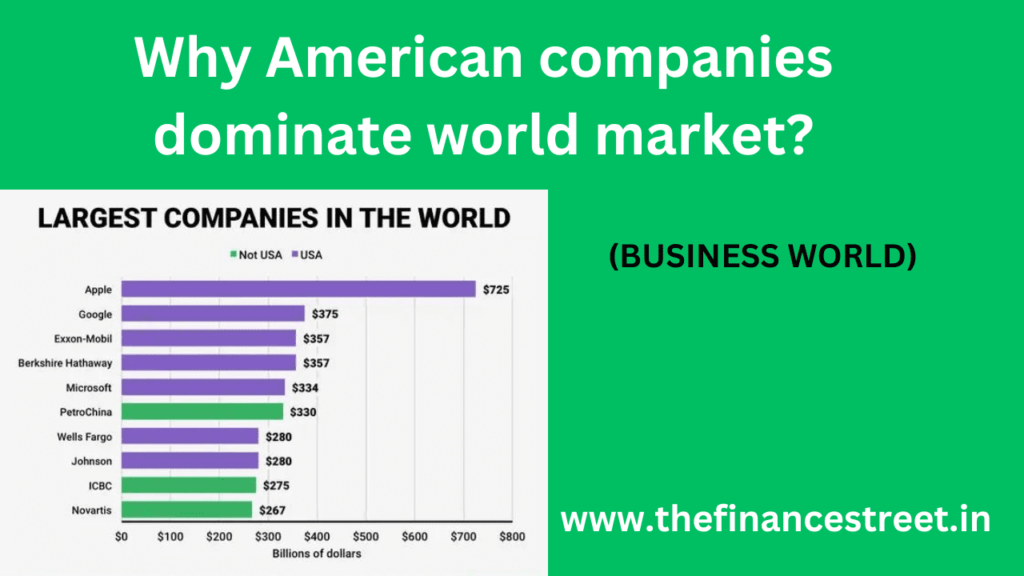Table of Contents
ToggleIntroduction-
In today’s globalized economy, the dominance of American companies of world market across various industries is a defining feature of international commerce. From tech giants like Apple and Google to retail powerhouses like Walmart, American firms wield significant influence and shape trends in the global marketplace. This phenomenon raises intriguing questions about the factors driving their dominance and the implications for global trade, economic development, and competition.
In this exploration, we delve into the underlying reasons why American companies have emerged as leaders in the world market. By examining key factors such as innovation, access to capital, market reach, and governmental support, we aim to gain insights into the dynamics shaping the competitive landscape on a global scale. Additionally, we’ll consider both the strengths and potential drawbacks of American companies’ dominance and its impact on various stakeholders, including consumers, competitors, and policymakers.
Through this analysis, we seek to gain a deeper understanding of the role American companies play in the global economy and the implications of their dominance for future economic growth, technological innovation, and international trade relations. Let’s embark on a journey to unravel the complexities and nuances of why American companies continue to dominate the world market.
Why American Companies dominate world market?
American companies dominate the world market for several reasons:
- Innovation and Technology: The United States has a long history of fostering innovation and technological advancement. American companies often lead the way in developing cutting-edge technologies, products, and services across various industries, including tech, pharmaceuticals, automotive, and finance.
- Access to Capital: The U.S. has a well-developed financial system with access to ample capital through venture capitalists, private equity firms, and public markets. This enables American companies to fund research, development, and expansion more easily than many of their international counterparts.
- Entrepreneurial Culture: The U.S. has a culture that celebrates entrepreneurship and risk-taking. This encourages individuals to start their own businesses and fosters an environment where innovation can thrive.
- Large Domestic Market: The United States has one of the largest consumer markets in the world, providing a strong foundation for domestic companies to grow and scale before expanding internationally.
- Global Reach: American companies often have extensive global networks, with subsidiaries, offices, and operations in multiple countries. This global reach allows them to access diverse markets and customer bases.
- Brand Power: Many American companies have built strong and recognizable brands that are trusted by consumers worldwide. These brands often signify quality, reliability, and innovation, giving American companies a competitive edge in international markets.
- Government Support and Policies: The U.S. government supports businesses through policies that promote innovation, trade, and competition. Additionally, government agencies such as the Small Business Administration provide resources and support to help companies grow.
- Educational Institutions: The United States is home to some of the world’s top universities and research institutions, which produce highly skilled graduates and conduct cutting-edge research. This talent pool feeds into the workforce of American companies, driving innovation and competitiveness.
- Flexible Labor Market: The U.S. labor market is relatively flexible compared to some other countries, allowing companies to adapt quickly to changing market conditions, restructure when necessary, and attract talent from around the world.
- Networking and Collaboration: American companies often collaborate with each other, forming strategic partnerships, alliances, and joint ventures. These collaborations enable them to leverage each other’s strengths and resources to compete more effectively in the global market.
While these factors contribute to the dominance of American companies in the world market, it’s essential to recognize that competition is increasing globally, and companies from other countries are also becoming major players in various industries.
What is the background history of Successful American Companies?
Successful American companies have diverse backgrounds, but many share common themes in their histories:
- Innovation and Entrepreneurship: Numerous American companies were founded by innovative entrepreneurs who identified opportunities and developed groundbreaking products or services. Examples include Thomas Edison’s General Electric, Steve Jobs and Steve Wozniak’s Apple Inc., and Bill Gates and Paul Allen’s Microsoft Corporation.
- Adaptability and Resilience: Many successful American companies have demonstrated the ability to adapt to changing market conditions and overcome obstacles. For instance, IBM transitioned from manufacturing punch card tabulating machines to becoming a leader in computer hardware and software services.
- Market Leadership and Dominance: Companies like Coca-Cola, McDonald’s, and Walmart have achieved success by establishing themselves as market leaders and leveraging their brand recognition and economies of scale to dominate their respective industries.
- Strategic Acquisitions and Partnerships: Some American companies have expanded their reach and capabilities through strategic acquisitions and partnerships. For example, Google’s acquisition of YouTube and Android helped it diversify its offerings and solidify its position in the tech industry.
- Customer-Centric Approach: Successful American companies often prioritize customer satisfaction and continuously strive to meet consumer needs and preferences. Amazon, for instance, has built its success on a relentless focus on customer service and convenience.
- Investment in Research and Development: Companies like Pfizer, Intel, and Tesla have thrived by investing heavily in research and development to drive innovation and stay ahead of competitors in rapidly evolving industries.
- Corporate Culture and Leadership: The culture and leadership of a company play a crucial role in its success. Companies such as Google, known for its innovative and employee-friendly culture, and Berkshire Hathaway, led by Warren Buffett’s value investing philosophy, have cultivated environments conducive to long-term growth and success.
- Global Expansion: Many successful American companies have expanded beyond domestic markets to tap into international opportunities. Companies like Starbucks, Nike, and McDonald’s have successfully established a global presence through strategic expansion and localization efforts.
Overall, the history of successful American companies is characterized by vision, innovation, adaptability, and a relentless pursuit of excellence. These companies have played a significant role in shaping the American economy and influencing business practices around the world.
What is the difference between American Companies in India for Global Perspectives?
When comparing American and Indian companies from a global perspective, several key differences emerge:
- Innovation and Technology Adoption: American companies are often perceived as more innovative and early adopters of new technologies compared to Indian companies. This innovation culture allows American firms to develop cutting-edge products and services, giving them a competitive advantage in the global market. Indian companies, while increasingly focusing on innovation, may sometimes lag behind in technology adoption due to various factors such as infrastructure limitations or cultural barriers.
- Access to Capital and Financial Systems: American companies benefit from a well-established financial system and access to abundant capital through venture capital, private equity, and public markets. In contrast, Indian companies may face challenges in accessing capital due to regulatory constraints or limitations in the financial ecosystem. However, with initiatives like India’s startup ecosystem and liberalization of financial markets, Indian companies are gradually improving their access to capital.
- Market Size and Diversity: The United States has a large and diverse domestic market, providing American companies with a solid foundation for growth. Indian companies, on the other hand, operate in a market with significant diversity in terms of culture, language, and consumer preferences. While India’s large population offers immense growth potential, companies must navigate complexities associated with diverse regional markets.
- Global Reach and Brand Recognition: American companies often have a more extensive global reach and stronger brand recognition compared to Indian companies. Many American brands are household names worldwide, contributing to their dominance in international markets. However, Indian companies are increasingly expanding their global footprint through strategic acquisitions, partnerships, and brand-building initiatives.
- Regulatory Environment and Government Policies: The regulatory environment and government policies differ significantly between the United States and India. American companies benefit from a business-friendly regulatory environment that fosters innovation, competition, and entrepreneurship. In contrast, Indian companies may encounter bureaucratic hurdles, complex regulations, and policy uncertainties that can impact their global competitiveness.
- Talent Pool and Educational Institutions: Both countries boast highly skilled workforces and prestigious educational institutions. However, the United States is home to some of the world’s top universities and research institutions, attracting talent from around the globe. Indian companies leverage the country’s vast pool of talent, including engineers, IT professionals, and management graduates, to drive innovation and growth.
- Cultural Differences and Management Styles: Cultural differences influence management styles and business practices in American and Indian companies. American companies often prioritize individualism, meritocracy, and flat organizational structures, fostering a culture of innovation and autonomy. In contrast, Indian companies may exhibit hierarchical structures, collectivist values, and emphasis on relationship-building, which can impact decision-making processes and organizational dynamics.
In conclusion, while American and Indian companies share common goals of global expansion and competitiveness, differences in innovation culture, access to capital, market dynamics, regulatory environments, talent pools, and management styles shape their approaches to international business. Understanding these differences is essential for companies seeking to navigate the complexities of the global marketplace effectively.
What is the role of Globalization for dominance of American Companies?
Globalization plays a significant role in facilitating the dominance of American companies in the world market. Several key factors contribute to this phenomenon:
- Market Access and Expansion Opportunities: Globalization has opened up new markets and created opportunities for American companies to expand their reach beyond domestic borders. The removal of trade barriers, advances in communication and transportation technologies, and the harmonization of regulatory frameworks have made it easier for American firms to penetrate international markets and establish a presence abroad.
- Supply Chain Integration and Efficiency: Globalization has led to the integration of supply chains on a global scale, allowing American companies to source materials, components, and labor from diverse locations around the world. This enables them to achieve cost efficiencies, optimize production processes, and respond quickly to changing market demands, enhancing their competitiveness in the global marketplace.
- Access to Talent and Expertise: Globalization has facilitated the movement of skilled labor and expertise across borders, enabling American companies to access talent pools from around the world. By recruiting top talent and leveraging diverse skill sets, American firms can drive innovation, creativity, and problem-solving capabilities, further strengthening their competitive advantage.
- Technology Transfer and Knowledge Sharing: Globalization has facilitated the transfer of technology and knowledge across borders, enabling American companies to leverage advancements in research, development, and innovation from around the world. This exchange of ideas and expertise enhances American firms’ capabilities to innovate, adapt, and stay ahead of competitors in rapidly evolving industries.
- Brand Recognition and Cultural Influence: Globalization has enabled American companies to build strong and recognizable brands that resonate with consumers worldwide. Through effective marketing, branding, and cultural adaptation strategies, American firms can establish emotional connections with consumers in different markets, fostering brand loyalty and driving demand for their products and services.
- Policy Advocacy and Influence: American companies often play a significant role in shaping global trade policies, regulatory frameworks, and standards through advocacy efforts, lobbying, and participation in international forums. By influencing policy decisions and shaping the global economic agenda, American firms can create an environment that is conducive to their interests and conducive to their dominance in the world market.
Overall, globalization provides American companies with access to new markets, resources, talent, and opportunities, enabling them to expand their presence, drive innovation, and maintain their dominance in the increasingly interconnected global economy. However, it also poses challenges such as increased competition, geopolitical risks, and regulatory complexities, which American companies must navigate strategically to sustain their leadership position in the world market.
Critical Analysis of American Companies dominate world market-
The dominance of American companies in the world market is a phenomenon that has been widely acknowledged and extensively studied. While there are undeniable factors contributing to this dominance, such as innovation, access to capital, and a large domestic market, a critical analysis reveals both strengths and potential drawbacks of this dominance.
Strengths:
- Innovation and Technology Leadership: American companies are renowned for their innovation and technological leadership across various industries. This innovation culture fosters continuous advancement, allowing American firms to develop cutting-edge products and services that meet evolving consumer needs and preferences.
- Access to Capital and Financial Systems: The United States boasts a robust financial system with access to abundant capital, enabling American companies to fund research, development, and expansion initiatives more easily than many of their international counterparts. This access to capital fuels growth and innovation, contributing to their dominance in the global market.
- Brand Power and Global Recognition: Many American companies have built strong and recognizable brands that are trusted by consumers worldwide. These brands signify quality, reliability, and innovation, giving American companies a competitive edge in international markets and facilitating market penetration and expansion.
- Large Domestic Market and Global Reach: With one of the largest consumer markets in the world, American companies have a solid foundation for growth and scalability. Moreover, their extensive global networks, with subsidiaries and operations in multiple countries, enable them to tap into diverse markets and customer bases, further solidifying their market dominance.
Drawbacks:
- Market Monopolization and Anti-competitive Practices: The dominance of American companies in certain industries has raised concerns about market monopolization and anti-competitive practices. Critics argue that this dominance stifles competition, limits consumer choice, and may lead to inflated prices or reduced innovation in the long run.
- Impact on Local Economies and Labor Practices: The expansion of American companies into international markets can have both positive and negative effects on local economies and labor practices. While American investment may create jobs and stimulate economic growth in some regions, it may also lead to exploitation of labor, environmental degradation, and cultural homogenization in others.
- Regulatory Arbitrage and Tax Avoidance: Some American companies engage in regulatory arbitrage and tax avoidance strategies to minimize their tax liabilities and maximize profits. These practices, while legal, have come under scrutiny for their potential negative impact on public finances and social welfare in both domestic and international contexts.
- Geopolitical Tensions and Trade Wars: The dominance of American companies in global markets can exacerbate geopolitical tensions and trade wars between nations. Conflicts over market access, intellectual property rights, and technology transfer may escalate, disrupting supply chains, increasing business uncertainty, and hampering global economic growth.
In conclusion, while American companies’ dominance in the world market brings undeniable benefits such as innovation, economic growth, and job creation, it also raises important questions regarding market competition, regulatory oversight, and social responsibility. A critical analysis recognizes both the strengths and drawbacks of this dominance, emphasizing the need for balanced policies and ethical business practices to ensure sustainable and inclusive global development.
Conclusion –
In conclusion, the dominance of American companies in the world market is a multifaceted phenomenon driven by a combination of factors such as innovation, access to capital, global reach, brand recognition, and favorable government policies. American firms leverage these advantages to expand their presence, drive growth, and maintain a competitive edge in the increasingly interconnected global economy.
However, this dominance also raises important questions and considerations regarding market competition, regulatory oversight, and social responsibility. Criticisms such as market monopolization, anti-competitive practices, and regulatory arbitrage underscore the need for balanced policies and ethical business practices to ensure sustainable and inclusive global development.
Moving forward, American companies must continue to innovate, adapt, and embrace responsible business practices to navigate the challenges and opportunities presented by globalization. By fostering collaboration, driving positive social impact, and embracing diversity and inclusion, American firms can continue to lead the way in shaping the future of the global economy while contributing to shared prosperity and well-being on a global scale.



